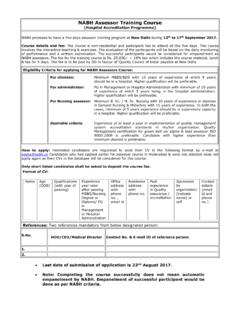Transcription of STANDARDS FOR NURSING EXCELLENCE - nabh.co
1 STANDARDS FOR NURSING EXCELLENCE First Edition October 2013 NATIONAL ACCREDITATION BOARD FOR HOSPITALS AND HEALTHCARE PROVIDERS 2 FOREWORD NURSING services are an integral part of the clinical services of any health care organization. The aim of NURSING services is to provide comprehensive NURSING care in terms of health promotion, prevention of diseases and therapeutic NURSING care to the patients in a HCO as well as to the community. The objective of the NURSING professional is to provide safe, competent and ethical NURSING care with compassion, comfort and collaboration with the patients, the family, the community and the clinical care team.
2 The NURSING professionals are the cornerstone of any quality related programme in a health care organization since most of the delivery and monitoring of health care is carried out by them. The NURSING professionals are the frontline staff with whom the patients, their families and the visitors interact first hand. Their knowledge, skills, attitude, communication and other soft skills thus make all the difference in the ultimate delivery of health care to the patients. STANDARDS are pre requisite for the promotion of safe, effective, competent and ethical NURSING care.
3 They help the individual NURSING practitioner to evaluate the services being provided by them and also act as a catalyst for self regulation and improvement. NURSING EXCELLENCE STANDARDS have been framed with a view to lay down the guidelines for evaluating the NURSING services being provided by a Health Care Organization, thereby providing a platform for continual improvement. These STANDARDS are applicable to all the Health care organizations irrespective of their size, role and complexity. They will help in regulating, guiding and promoting professional NURSING practice.
4 They will serve as guidelines to nurse administrators and supervisors for supporting and facilitating safe, competent and ethical NURSING practices within their Health Care Organizations. Apart from serving as a frame work for evaluation of the quality of NURSING services rendered, these STANDARDS will also provide guidelines to assist nurses in decision-making and will support the NURSING efforts by outlining the professional expectations 3 from the NURSING services. The STANDARDS are on the same framework as has been for the NABH STANDARDS for Health Care Organizations.
5 The 1st edition of NURSING EXCELLENCE STANDARDS is divided into 07 chapters, focusing on various professional, administrative and governance aspects of NURSING . Seven chapters are further divided into 48 STANDARDS . Put together there are 216 objective elements incorporated within these STANDARDS . Objective elements are required to be complied with in order to meet the requirement of a particular standard. Similarly, STANDARDS are required to be complied with, in order to meet the requirement of a particular chapter.
6 Finally all chapters are deciding factor to say whether a hospital is meeting the requirements of the certification program. In the beginning of each chapter, intent is given to highlight the summary of the chapter. For most of the objective elements, interpretation is provided just to further elaborate on how that objective element can be met. STANDARDS are dynamic and would be under constant review process. Comments and suggestions for improvement are appreciated. We seek your support in keeping these STANDARDS adequate to the need of industry.
7 4 TABLE OF CONTENTS Chapter No Particulars Page No. Chapter:1 NURSING Resource Management (NRM) Chapter:2 NURSING Care of Patient (NCP) Chapter:3 Management of Medication (MOM) Chapter:4 Education, Communication and Guidance (ECG) Chapter:5 Infection Control Practices (ICP) Chapter:6 Empowerment and Governance (EG) Chapter:7 NURSING Quality Indicators (NQI) Glossary 5 CHAPTER 1 NURSING RESOURCE MANAGEMENT Intent of the chapter: NURSING staff is the most important resource of a hospital and healthcare system.
8 The goal of NURSING resource management is to acquire, provide, retain and maintain competent staff nurse in right numbers to meet the needs of the patients and community served by the organization. Training and development of the NURSING staff must be in consonance with the expected performance in the present and future anticipated jobs. The NURSING professionals shall be provided with opportunities for professional advancement. The organization shall lay down the job description and procedures for credentialing and privileging of the NURSING staff.
9 There shall be an established procedure for addressing grievances. 6 Summary of Standard The organization has a documented system of NURSING resource planning. The organization has structures and processes for induction and for enhancing the transition of novices to competent NURSING professionals. The organization has processes in place for induction training, In-service education and Continuous NURSING Education (CNE) programmes and for documentation of the same in the personal files. There is a process for credentialing and privileging of NURSING professionals, permitted to provide patient care without supervision.
10 An appraisal system for evaluating the performance of NURSING staff exists as an integral part of the NURSING resource management process. There is a provision for acknowledging outstanding performances/ contributions of NURSING professionals. There is an established process in place to identify and manage problems related to incompetent, unsafe or unprofessional conduct. The organization demonstrates workplace safety for NURSING professionals and protection of their rights. The organization has a documented and established grievance handling system.










